3 MIN READ
Effect of Soybean Seeding Rate and Row Spacing on Yield and Profitability
December 9, 2021
TRIAL OBJECTIVE
Improvements in soybean genetics, planting technology, and weed control systems have led to lower planting rate recommendations for soybean growers1 over the past decade.
Although yields generally increase with increasing planting rates, commodity prices affect which planting rate will be most economical.
This research was conducted with a goal of understanding the impact of plant population and row spacing on yield and grower profitability.
RESEARCH SITE DETAILS
This research was conducted at Bayer Crop Science FOCUS sites in Illinois counties, Kendall, Dekalb, and Woodford from 2019-2021.
Sixteen 2.2-2.9 maturity group (MG)soybean products were planted, with different soybean products used in different years.
Seeding rates ranged from 60,000 to 160,000 planted seeds per acre.
Four replications of this trial were planted at each location and year.
The 2019 growing season was very cool and wet through early June, leading to delayed planting for many growers. Hot and dry conditions were prevalent in July and August, and excessive rainfall returned in September and October.
In both 2020 and 2021, there was sufficient moisture in the early part of the growing season, but very dry conditions throughout August and into September.
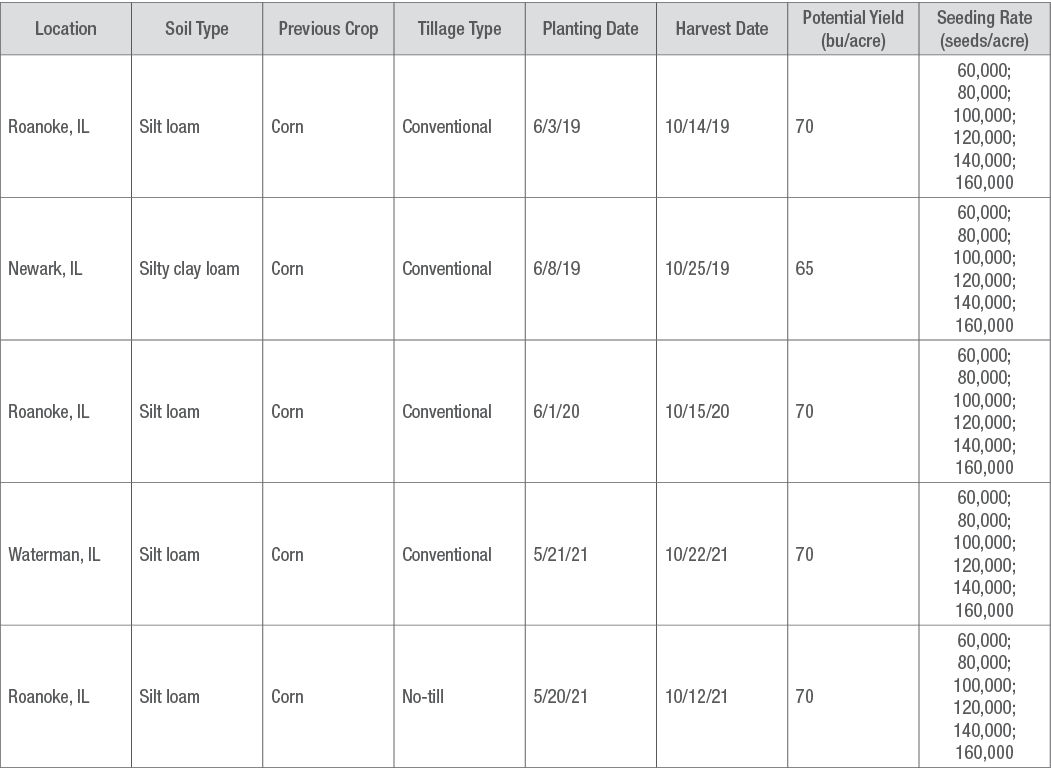
UNDERSTANDING THE RESULTS
On average, over the 3 years in this research, the highest yielding configuration was 160,000 seeds/acre, planted in 20-inch rows (Figure 1).
Based on soybean grain value of $12/bushel, the most profitable planting configuration is also 160,000 planted seeds/acre in 20-inch rows (Figure 1).
When a soybean commodity value of $8/ bushel is used for calculations (Figure 2), a planting rate of 160,000 seeds/acre is still the most profitable. However, the profitability curve is relatively flat at planting rates from 120,000 to 160,000
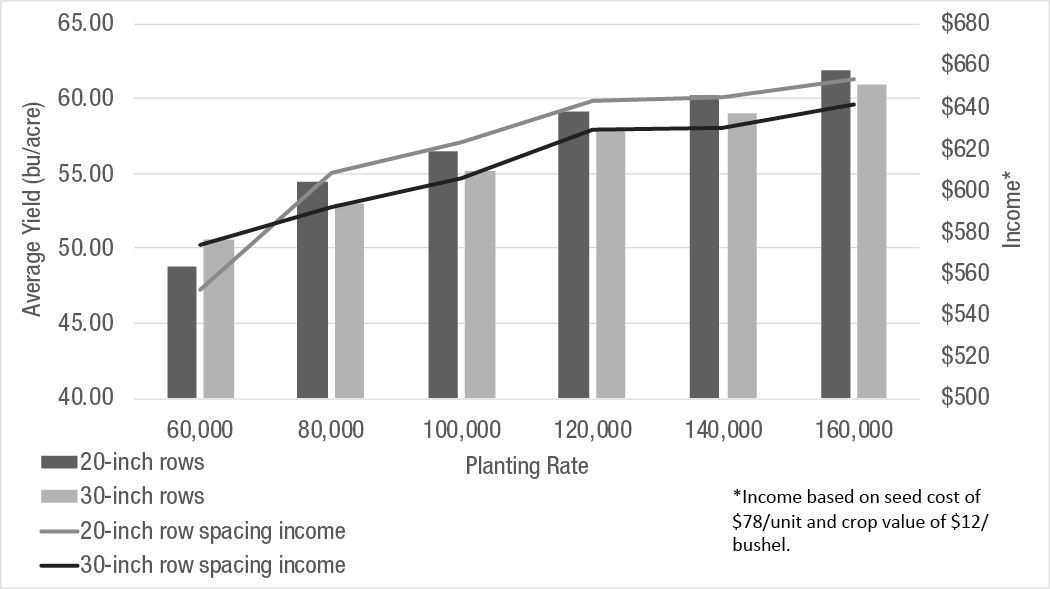
Figure 1. Average soybean performance and profitability under different row widths and seeding rates in Illinois, 2019-2021.
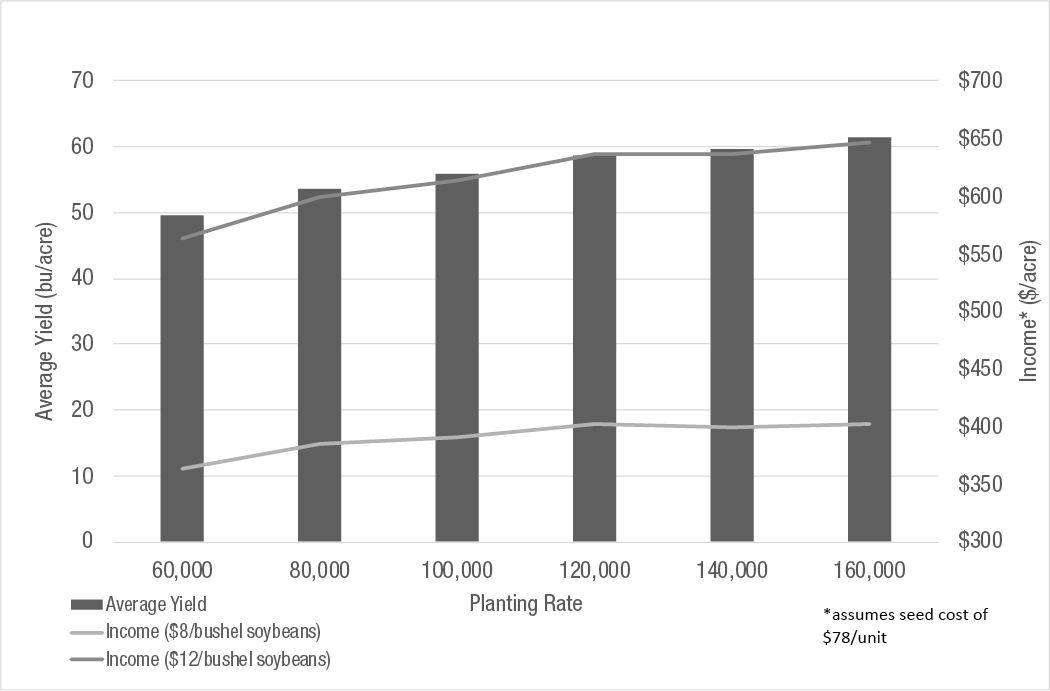
Figure 2. Effect of commodity price on average profitability of different planting rates in Illinois, 2019-2020.
KEY LEARNINGS
Although the average planting date in this research was later than growers would typically wish to plant, the results are representative of what we see in earlier plantings; there is typically less yield effect related to a correlation between planting dates and planting rates than generally accepted2.
Although a planting rate of 120,000 seeds/acre will sometimes be sufficient to maximize profitability, growers wishing to increase yield or anticipating higher commodity prices may increase planting rates up to 160,000 without incurring much additional risk from an income perspective.
Sources:
1Licht, M. Soybean plant population. Iowa State University. https://crops.extension.iastate.edu/encyclopedia/soybean-plant-population
2Pedersen, P. Optimum plant population in Iowa. Iowa State University. https://crops.extension.iastate.edu/files/article/OptimumPlantPop_000.pdf
Effect of Soybean Seeding Rate and Row Width on Agronomic Characteristics and Yield for June Plantings - 2020
TRIAL OBJECTIVE
Agronomists and University specialists typically recommend increasing soybean seeding rates when planting later than normal.1
In late-planted soybean crops, higher seeding rates can increase the efficiency of available sunlight since later plantings have less time to grow vegetatively prior to the beginning of pod production.2
Narrow rows help speed crop canopy development and can reduce weed pressure.3
RESEARCH SITE DETAILS

This trial was conducted at Bayer Crop Science FOCUS sites at Roanoke, Illinois (2019 and 2020) and Newark, Illinois (2019).
Ten maturity group (MG) 2.2 to 2.9 soybean products were planted in June.
Seeding rates included 60,000, 80,000, 100,000, 120,000, 140,000 and 160,000 seeds/acre.
Four replications were planted at each location.
The 2019 growing season was very cool and wet through early June, delaying planting for many growers. Hot and dry conditions were prevalent in July and August, and excessive rainfall returned in September and October.
In 2020, there was sufficient moisture in the early portion of the growing season and drought conditions throughout August and into early September.
All soybean products planted in this trial were treated with the same seed treatment.
UNDERSTANDING THE RESULTS
Although the highest average yield was achieved at a seeding rate of 160,000 seeds/acre in 30-inch rows, the most profitable configuration in this study was a seeding rate of 100,000 seeds/acre in 20-inch rows.
The highest return on investment (ROI) occurred at a seeding rate of 160,000 seeds/acre for 30-inch rows and 100,000 seeds/acre for 20-inch rows.
Overall, lodging scores were low; however, standability decreased as seeding rates increased.
Overall, disease prevalence was low; however, incidence increased slightly as seeding rates increased

Figure 1. Average soybean yield and profitability of ten soybean products (MG 2.2 to 2.9) by seeding rate and row spacing across locations and years.
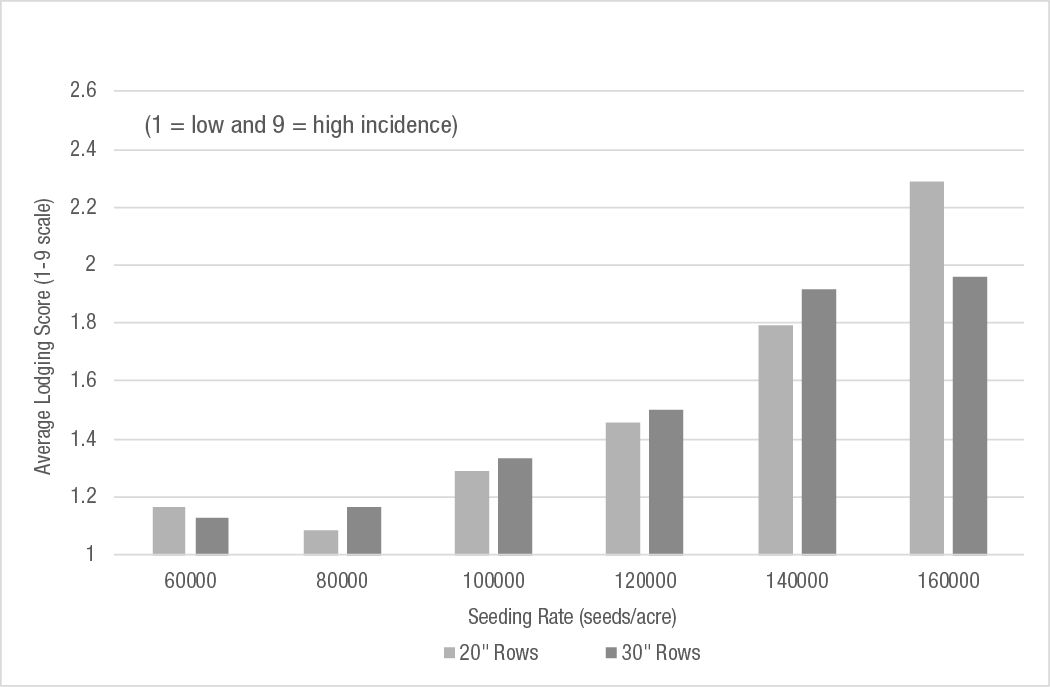
Figure 2. Lodging incidence relative to row width and seeding rate for six soybean products (MG 2.2 to 2.8) at Roanoke, IL (2020).
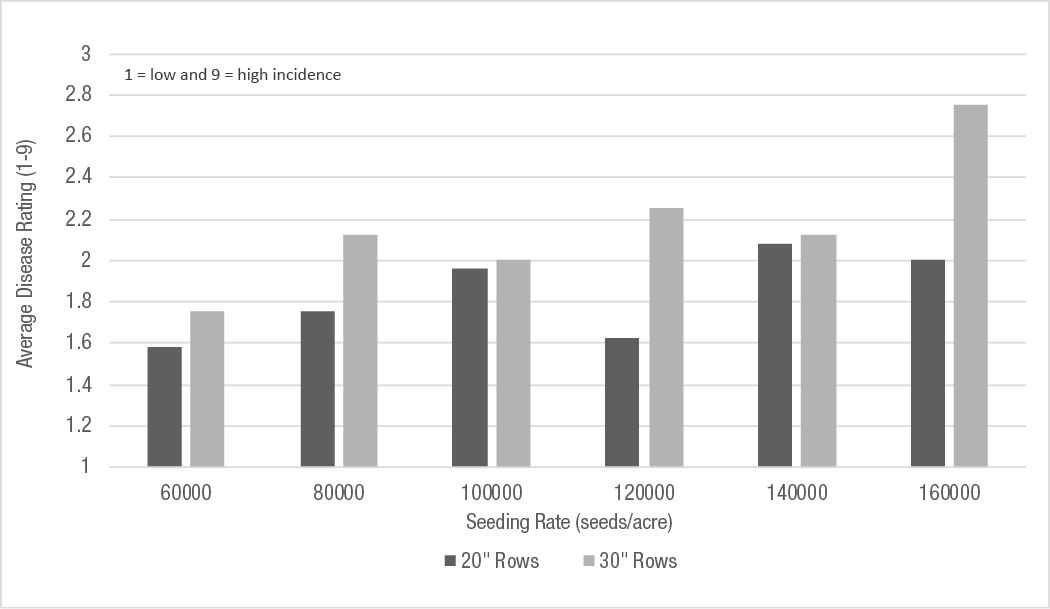
Figure 3. Average incidence of disease development (visual) by row width and seeding rate for six soybean products (MG 2.2 to 2.8) at Roanoke, IL (2020).
KEY LEARNINGS
- The results support prior studies:
- When planting soybean seed in June in 30-inch rows, the average return on investment and yield was highest at 160,000 seeds/acre. Since this was the highest seeding rate in the study, it is possible that higher seeding rates may increase yield.
- When planting soybean seed in June in 20-inch rows, maximum profitability was obtained by planting at a seeding rate of 100,000 seeds/acre, but yield was maximized at 140,000 seeds/acre.
- Lodging and disease prevalence are generally less when planting late but become more problematic with increased seeding rates.
Sources:
1 De Bruin, J.L. and Pedersen, P. 2008. Soybean seed yield response to planting date and seeding rate in the upper Midwest. Agronomy Journal. Volume 100, Issue 3.
2 Ball, R.A., Purcell, L.C., and Vories, E.D. 2000. Optimizing soybean plant population for a short-season production system in the southern USA. Crop Science. Volume 40, Number 3.
3 Harder, D.B., Sprague, C.L., and Renner, K.A. 2007. Effect of soybean row width and population on weeds, crop yield, and economic return. Weed Technology. Volume 21, Issue 3.
Effect of Soybean Seeding Rate and Row Width on Yield in Late Plantings - 2019
TRIAL OBJECTIVE
Agronomists and universities typically recommend increased seeding rates when planting soybeans later than normal.1
Increased populations in later plantings allow more efficient use of available sunlight since later-planted soybeans have less time to grow vegetatively prior to reproduction.2
Narrow-row soybean plantings decrease the time required for the crop to reach canopy closure and can result in lower weed pressure.3
RESEARCH SITE DETAILS

This trial was conducted at Bayer Crop Science FOCUS sites in Woodford and Kendall Counties, Illinois.
Six soybean varieties (ranging from 2.4-2.9 relative maturity) were planted in June.
Seeding rates ranged from 60,000 to 160,000 seeds/acre.
Two planting configurations were tested, 20-inch and 30-inch rows.
Four replications of this trial were planted at each location.
The 2019 growing season was very cool and wet through early June, leading to delayed planting for many growers. Hot and dry conditions were prevalent in July and August, and excessive rainfall returned in September and October.
UNDERSTANDING THE RESULTS
Although the highest yield in this study was achieved at a seeding rate of 160,000 seeds/acre in 30-inch rows, the most profitable configuration was a seeding rate of 100,000 seeds/acre in 20-inch rows.
160,000 seeds/acre were required to receive the highest return on investment (ROI) in 30-inch rows, whereas the highest ROI was achieved at 100,000 seeds/acre in 20-inch rows.
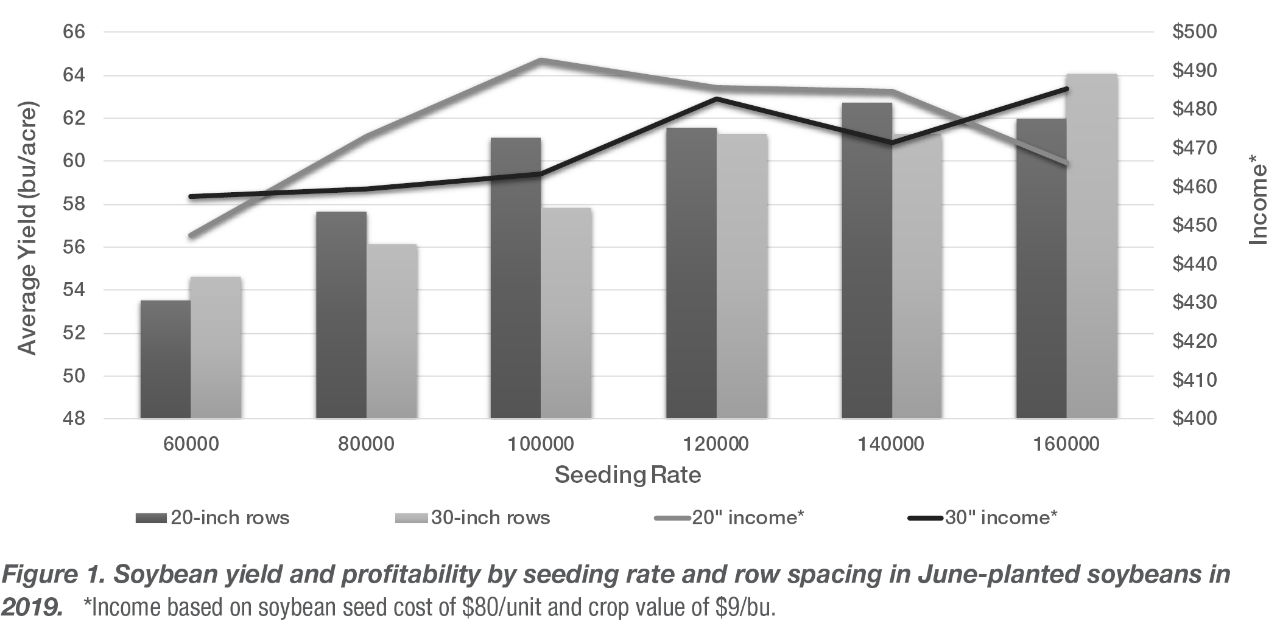
KEY LEARNINGS
These results support those of previous studies.1,2 When planting soybeans in June in 30-inch row spacing in this study, both ROI and overall yield were highest at a seeding rate of 160,000 seeds/acre. Since this was the highest seeding rate in the study, it is possible that increasing the seeding rate even higher would continue to improve yield.
However, when planting soybeans in June in 20-inch rows in this study, maximum profitability was obtained by planting at a seeding rate of 100,000 seeds/acre, but the highest yields were obtained at a seeding rate of 140,000 seeds/acre.
Sources:
1 De Bruin, J.L. and Pedersen, P. 2008. Soybean seed yield response to planting date and seeding rate in the upper Midwest. Agronomy Journal. Volume 100, Issue 3.
2Ball, R.A., Purcell, L.C., and Vories, E.D. 2000. Optimizing soybean plant population for a short-season production system in the southern USA. Crop Science. Volume 40, Number 3.
3Harder, D.B., Sprague, C.L., and Renner, K.A. 2007. Effect of soybean row width and population on weeds, crop yield, and economic return. Weed Technology. Volume 21, Issue 3.